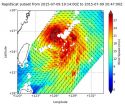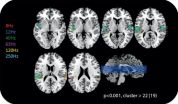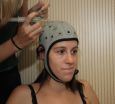Spotting the elephant not in the room
2015-07-10
(Press-News.org) An automated thermal detection system that can discern wild elephants from background and other animals in infrared images could save lives in parts of the world where the animals roam free and often enter villages and other human habitation, according to research published in the International Journal of Electronic Security and Digital Forensics.
Siva Mangai and colleagues at Karunya University, in Coimbatore, Tamil Nadu, India, explain how encounters between humans and elephants is a critical safety issue in the Western Ghats region of Tamil Nadu. "The movement of wild elephants crossing the forest borders and the preventive measures taken causes damage to the lives of both people and elephants," the team explains. They suggest that automated processing of infrared images from cameras placed at strategic locations might provide an early-warning system and reduce such encounters to the mutual benefit of both elephants and people.
However, object recognition remains a challenging task. The team has now developed a clustering-based image segmentation approach for accurate elephant recognition in infrared images. Segmentation is a process of grouping a set of objects into segments of similar characteristics. It has been extensively used in many areas, such as statistics, signal processing and pattern recognition, the team explains. The algorithm they have developed that uses this approach could serves as the basis for developing a very large scale integration (VLSI)-based system to detect elephants so that they can be safely prevented from crossing forest borders and entering villages.
Tests with images of elephants, horses, bears, cattle and other animals likely to be in the forest gave a recognition rate of almost 95 percent. The few false positives would be offset by lives and property saved from wild elephants entering a village.
INFORMATION:
Mangai, N.M.S., Vinod, S.T. and Chandy, D.A. (2015) 'Recognition of elephants in infrared images using clustering-based image segmentation', Int. J. Electronic Security and Digital Forensics, Vol. 7, No. 3, pp.234-244.
ELSE PRESS RELEASES FROM THIS DATE:
2015-07-10
NASA's Aqua satellite saw the massive Typhoon Nangka moving out of the Marianas Islands, while NASA's RapidScat instrument pinpointed the location of its strongest winds.
On July 9, the RapidScat instrument that flies aboard the International Space Station, observed Nangka's strongest winds on the western side of the storm, reaching speeds of more than 30 meters per second (108 kph/67 mph). RapidScat scanned the storm's surface winds for about 90 minutes from 1:41 p.m. to 3:14 p.m. EDT.
When Aqua passed over Typhoon Nangka on July 10 at 01:10 UTC (9:10 a.m. EDT ...
2015-07-10
NOAA's GOES-West satellite saw that Hawaii is in the middle of a triangle of tropical cyclones. Post-Tropical Depression Ela was located northeast of Hawaii on July 10, and the forecast calls for the storm to move west toward the islands over the weekend of July 11 and 12 and dissipate.
There are three tropical cyclones in the Central Pacific Ocean and Hawaii is in the middle of them. On July 10, newborn Tropical Depression 01C was west of Hawaii, while newborn Tropical Depression 02C was south of the Big Island. Post-Tropical Depression Ela was northeast of the islands ...
2015-07-10
RapidScat is an instrument that sits on the International Space Station and reads surface winds over the ocean. It has been invaluable to tropical cyclone forecasters, showing where the strongest winds are located in storms. RapidScat spotted Chan-Hom's strongest winds away from Taiwan as it approached mainland China for landfall.
On July 9, the RapidScat instrument that flies aboard the International Space Station, observed Chan-Hom's strongest winds stretched from the northwestern to southeastern side of the storm, reaching speeds of more than 30 meters per second (108 ...
2015-07-10
DETROIT - A Wayne State University School of Medicine professor, in collaboration with researchers at CReAte Fertility Center, University of Toronto, Harvard University and Georgia Reagents University, has developed the first diagnostic test for sperm RNA based on next-generation sequencing. For couples with unexplained infertility, the test may help determine the best infertility treatment for couples having difficulty conceiving.
Published this week in Science Translational Medicine, "Absence of sperm RNA elements correlates with idiopathic male infertility," by the ...
2015-07-10
This news release is available in German.
Are wind farms harmful to humans? Some believe so, others refute this; this controversial topic makes emotions run high. To give the debate more objectivity, an international team of experts dealt with the fundamentals of hearing in the lower limit range of the audible frequency range (i.e. infrasound), but also in the upper limit range (i.e. ultrasound). The project, which is part of the European Metrology Research Programme (EMRP), was coordinated by the Physikalisch-Technische Bundesanstalt (PTB). At PTB, not only acoustics ...
2015-07-10
July 10, 2015 - For children with cleft lip and palate, the chances of undergoing secondary surgery vary depending on the center where they're treated, reports a study in Plastic and Reconstructive Surgery--Global Open®, the official open-access medical journal of the American Society of Plastic Surgeons (ASPS).
When secondary surgeries are performed, they don't necessarily improve the child's final facial appearance, according to the new research by ASPS Member Surgeon Dr. Thomas J. Sitzman of Cincinnati Children's Hospital Medical Center and colleagues.
Secondary ...
2015-07-10
Random-access memory, or RAM, is where computers like to store the data they're working on. A processor can retrieve data from RAM tens of thousands of times more rapidly than it can from the computer's disk drive.
But in the age of big data, data sets are often much too large to fit in a single computer's RAM. The data describing a single human genome would take up the RAM of somewhere between 40 and 100 typical computers.
Flash memory -- the type of memory used by most portable devices -- could provide an alternative to conventional RAM for big-data applications. It's ...
2015-07-10
LEXINGTON, Ky. (Jul. 10, 2015) -- Macrophages are cellular sentinels in the body, assigned to identify "attacks" from viruses, bacteria, or fungi and sound the alarm when they are present. However, these cells are a "double edged sword" in spinal cord injury, providing both neural repair-promoting properties and pathological functions that destroy neuronal tissue
"We know from previous research that macrophages are versatile, and signals at the injury site can stimulate repair or destruction--or confusingly, both," said John Gensel Ph.D., Assistant Professor of Physiology ...
2015-07-10
This news release is available in Spanish.
Scientists at the Centre for Genomic Regulation (CRG), the research company Starlab and the group BR::AC (Barcelona Research Art & Creation) of the University of Barcelona developed a device that produces sounds from brain signals. This highly interdisciplinary team is led by Mara Dierssen, head of the Cellular & Systems Neurobiology group at CRG. Its ultimate goal is to develop an alternative communication system for people with cerebral palsy to allow them to communicate--and more specifically in this pilot phase, ...
2015-07-10
The great white shark (Carcharodon carcharias) has a terrifying reputation. Shark attacks, though very rare, loom large in our imaginations, drawing intense media attention when they occur. Recent injuries in North Carolina are putting sharks in the limelight again. But going after sharks à la Jaws is not the best way to protect people in the water, said shark researchers.
California scientists found that the risk of white shark attack for individual ocean users in California has fallen strikingly, by over 91 percent, since 1950, in a study to be published online ...
LAST 30 PRESS RELEASES:
[Press-News.org] Spotting the elephant not in the room




